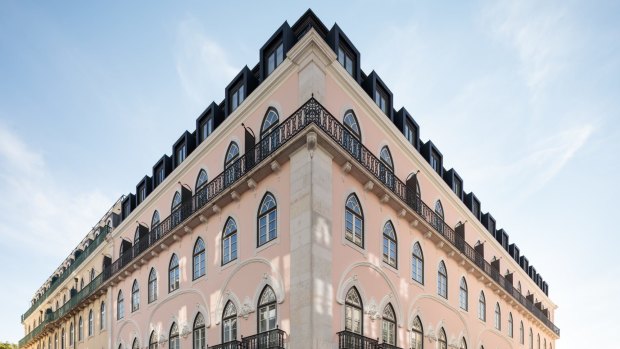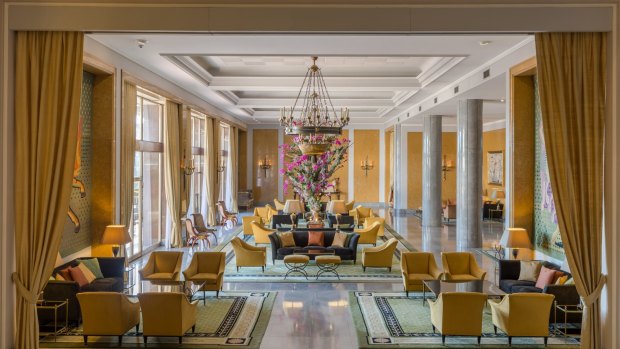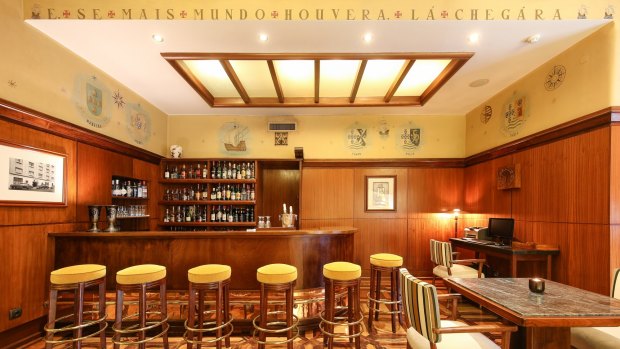This was published 2 years ago
Lisbon design and architecture: Tour the city's hidden design delights
By Kate Armstrong

Hotel Ivens, an 87-room boutique hotel that opened in 2021.Credit: Francisco Nogueira
When Joana Alves, co-owner of Alcoa, one of Portugal's most famous traditional patisseries, walked past an empty store – a former lottery ticket kiosk – in Lisbon's Chiado, she peeked through a narrow gap where a strip of paper had peeled away from the window. Through this slither she could distinguish a series of coloured enamel tiles with abstract motifs that covered the walls. Unlike Portugal's common azulejos (tiles) these were made by Querubim Lapa, a renowned Portuguese potter and artist, in 1963. Alves had won the jackpot; this was the ideal spot for Alcoa's Lisbon locale.
I, too, have a windfall. As I eat a cornucopia (Alcoa's most popular pastry) and peruse the cafe's sensitive renovation that incorporates the art work, I realise that a piece by Querubim Lapa's is showcased in the The Ritz Four Seasons, my accommodation for two nights. This revelation alters my course.
I'd intended to spend the day sniffing out Lisbon's chic Scandinavian-styled locales (a current design trend favoured by young cafe owners who've blitzed the city over the past decade). But now, because of some quirky tiles, I'm about to head down a rabbit hole. This will take me through Lisbon's design eras: the art deco '40s; mid-century '50s and back again to the present.

The Ritz Four Seasons: The hotel could be a museum.Credit: Loop Audiovisual
Such diversions can occur when visiting Lisbon, a creative city with a legacy of excellent design that ranges from 18th century wrought-iron and tile-clad mansions, to Manueline-style structures and cutting-edge buildings, such as the office headquarters of Energia de Portugal (EDP).
But by now, intrigued by Querubim Lapa, I race to view his "naïve" ceramic that hangs in the The Ritz Four Seasons. It's beautiful. As is the hotel.
The Ritz Four Seasons was completed in 1959, at the request of the dictator, Antonio de Oliveira Salazar to respond to international tourism after World War II and to promote Lisbon as a "modern" city. It was an ambitious task; Portugal's contemporary artists were commissioned to create pieces for the hotel alone.

Hotel Britania's glamorous Imperio Bar.Credit: Telmo Miller
These days, the public can view these extraordinary art works: Almada Negreiros' cubist-style Centaur trilogy of tapestries; Carlos Botelho's oil paintings; and Sarah Afonso's tapestries, titled (coincidentally), "The Four Seasons". But if the artworks resemble a gallery, the hotel could be a museum.
In 2021, The Ritz launched its refurbished suites following a major reincarnation by designers Artur Miranda and Jacques Bec. Regarding the project as "a curatorship", the duo maintained the architectural integrity and classic aesthetics of the 1950s – low mid-century lines in the rooms' chaise lounge, desk chair and bed stools – while introducing modern elements such as gizmo-friendly outlets and massive TV screens. The palette comprises beige and a blend of blues: greyish blue, petroleum blue and anthracite grey. Even the carpet features a geometric wave motif that appears in Almada Negreiros' tapestry, "Olissipo" (the ancient name for Lisbon). The bathrooms are pure art deco and I can't get enough of their marble walls and chrome fixtures.
My new-found interest in art deco leads me to my next stop, Hotel Britania. This 33-room hotel was designed in 1942 by Portuguese modernist architect Cassiano Branco and it's the only hotel of the art deco period to have survived intact. The lobby's glamourous Imperio Bar (open to the public) – with its line of chrome-trimmed, orange-seated bar stools and curved mahogany bar – is a time capsule; you can almost hear the rustling of taffeta and the hum of a cocktail chatter among its regular patrons: politicians and intellectuals; writers and poets.
The swinging '70s brought different ideas: the owners lowered the ceilings and covered the walls in dark brown wood to create an atmosphere reminiscent of a British gentlemen's club. In the 1990s, the current proprietors, the Alves de Sousa and Fernandes families, reinvigorated the hotel's former glory. Consulting old photos, they painstakingly peeled back coverings with spectacular results: the original cork floors; frescos; and superb art deco trimmings, including cocktail carts and chandeliers.
It's a shock to return to the "present", as I head to Hotel Ivens, an 87-room boutique hotel that opened in 2021 after an overhaul of the historic building (with the exception of the striking pale pink exterior and gothic windows which have heritage protection).
The hotel was named after Roberto Ivens and Hermenegildo Capelo, two 19th-century expeditioners who explored a decent chunk of Africa. Adventure awaits me.
Visiting here is like embarking on a stimulating trip through a modern-day "jungle". The hotel's common areas, including the bars and restaurant (the Rocco Crudo Bar, Gastro Bar and Ristorante), scream "maximalism" thanks to Catalan designer Lazaro Rosa-Violan. The compact, yet comfortable, lobby blends Africa and the Mediterranean: warm woods; colourful African fabrics; and Middle Eastern rugs. Plus velvet and rattan textiles, leather chairs and a carpet pattern that explodes with a tangle of fronds.
It's another story in the suites where the interiors – the work of Portuguese interior designer, Cristina Matos – are way more discreet, with pleasant cream and brown accents.
But nowhere provides more sensory overload than the hotel's public restrooms. Here, shiny black toilets are camouflaged against wallpaper plastered with macaws and feathered friends of all kinds.
I'm so distracted by the wild experience that it takes me several seconds to locate the exit; the pixellated tile patterns are as confusing as a carnival's hall of mirrors. But I'm under no illusion: while I might be satisfied by a regular commode, Instagram crowds will love this bladder-bursting experience.
I navigate my way to my room, prepare a Rishi tea and settle into a cosy window nook; I love the room's tranquility.
And I'm grateful that it's just one of many classy – and very creative – corners ready for exploration in this design-oriented city.
The writer was a guest of Turismo de Lisboa, Four Seasons Hotel Ritz, Hotel Britania and The Ivens Hotel.
THE DETAILS
MORE
The best place to hone up on Art Deco design is at the newly opened B-MAD, Berardo Museu Art Deco. Opened in April 2021, it displays original works by famous makers: from elaborate desks to lamps, ceramics to glassware. See bmad.pt 10am-5pm daily, free one hour tour (must reserve one day in advance).
STAY
Hotel Britania, rooms from $150 a night, see lisbonheritagehotels.com
Hotel Ivens, from $300, see theivenshotel.com; rocco.pt
Four Seasons Hotel Ritz from $900, see fourseasons.com/lisbon
Pestana Lisboa Vintage Hotel from $125, see pestana.com/en/
WC by Boutique From $130, see thebeautiquehotels.com
PORTUGUESE DESIGNER – DACIANO DA COSTA
Few people outside Portugal (beyond designer die-hards) are aware of 20th century Portuguese creative, Daciano da Costa. And this is surprising. A prolific artist, architect, industrial and interior designer whose work spans 50 years, his range of household items and furniture grace many of Portugal's public buildings, offices and homes. His works represent mid-century design at its best. For the most accessible examples of his designs? Head to the National Library of Portugal (bnportugal.gov.pt) where the delightful reading room is lined with long wooden tables and low-backed, crimson-leather chairs, plus wooden catalogue drawers. Or visit Fundacao Calouste Gulbenkian (gulbenkian.pt/en), a stunning modern art gallery. He was responsible for outfitting many of its public areas. For more on his work see dacianodacosta.pt
Sign up for the Traveller Deals newsletter
Get exclusive travel deals delivered straight to your inbox. Sign up now.